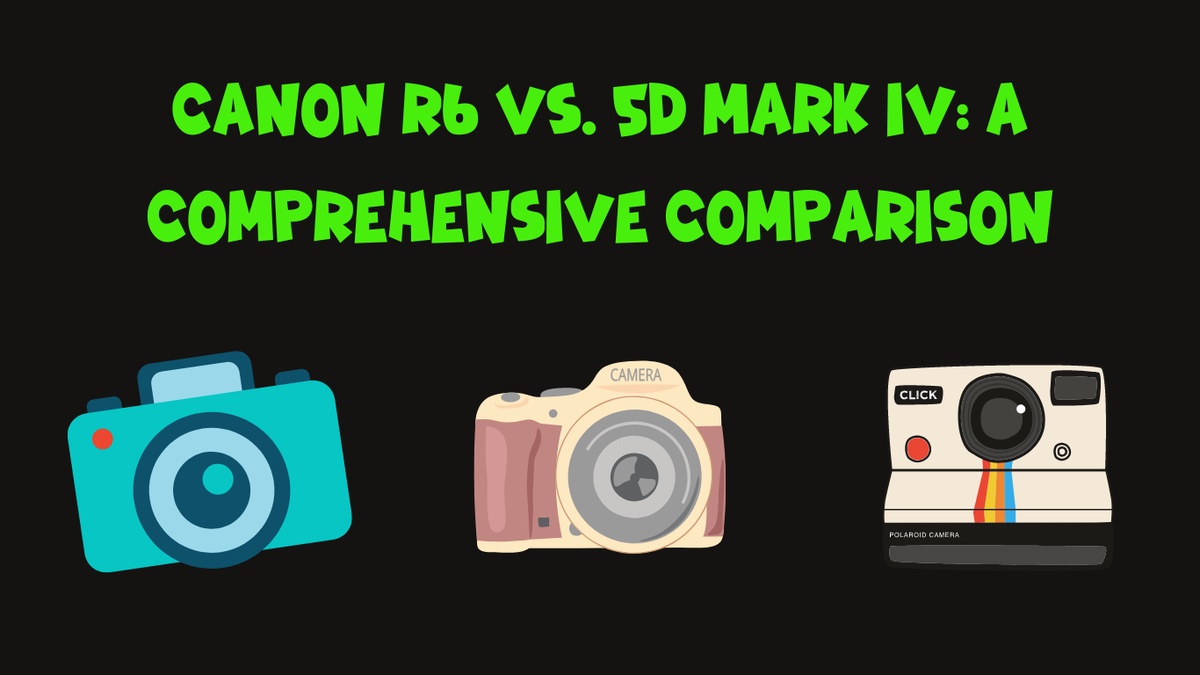Are you considering investing in a new camera and finding yourself torn between the Canon R6 and the 5D Mark IV? Both of these cameras offer impressive features and capabilities, but understanding their differences is crucial to making an informed decision. In this article, we will delve into the details of each camera, comparing their image quality, autofocus system, video capabilities, burst shooting, and more. By the end, you'll have a clearer picture of which camera suits your needs. Let's jump right in!
Introduction
Before diving into the nitty-gritty details, let's get acquainted with the Canon R6 and the 5D Mark IV. The Canon R6 is a mirrorless camera that offers cutting-edge technology and versatility, while the 5D Mark IV is a highly regarded DSLR that has been a favorite among professional photographers for years. Both cameras come from Canon's esteemed lineup, but they cater to slightly different audiences and shooting styles.
Overview of Canon R6
The Canon R6 is a full-frame mirrorless camera that packs a punch when it comes to features and performance. With a 20.1-megapixel CMOS sensor, the R6 delivers excellent image quality with remarkable detail and dynamic range. Its native ISO range of 100-102,400 ensures impressive low-light performance, allowing you to capture stunning shots even in challenging lighting conditions.
Overview of Canon 5D Mark IV
The Canon 5D Mark IV, on the other hand, is a workhorse DSLR that has gained a strong reputation among professional photographers. It boasts a 30.4-megapixel full-frame CMOS sensor, delivering high-resolution images with rich colors and fine details. The 5D Mark IV offers a native ISO range of 100-32,000, expandable up to 50-102,400, allowing for excellent low-light capabilities.
Comparison of Image Quality
When it comes to image quality, both the Canon R6 and the 5D Mark IV excel in their respective domains. The R6's 20.1-megapixel sensor may seem lower in resolution compared to the 5D Mark IV, but it compensates with larger individual pixels, resulting in improved low-light performance and dynamic range. On the other hand, the 5D Mark IV's higher resolution sensor captures finer details, making it a great choice for photographers who require maximum resolution.
In terms of dynamic range, both cameras offer excellent results, but the R6's sensor technology provides a slight edge in preserving highlight and shadow details. This can be especially advantageous in high-contrast situations or when recovering details in post-processing.
Autofocus System
The autofocus system is a crucial factor to consider, particularly for photographers who frequently capture fast-moving subjects or engage in sports photography. The Canon R6 features an advanced Dual Pixel CMOS AF II system with 6,072 autofocus points, covering approximately 100% of the frame horizontally and 88% vertically. This extensive coverage ensures exceptional subject tracking and accuracy, even in challenging conditions.
On the other hand, the 5D Mark IV utilizes Canon's renowned 61-point High-Density Reticular AF system, providing reliable autofocus performance. While it may have fewer autofocus points compared to the R6, the 5D Mark IV still delivers highly accurate and precise focusing, making it suitable for various photography genres.
Video Capabilities
Both the Canon R6 and the 5D Mark IV offer impressive video capabilities, but there are some differences to consider. The R6 shines as a versatile video tool, supporting 4K video recording at up to 60 frames per second (fps) and full HD recording at up to 120 fps. Additionally, it features Canon's Dual Pixel CMOS AF technology, providing smooth and precise autofocus during video capture.
The 5D Mark IV, on the other hand, offers 4K video recording at up to 30 fps and full HD recording at up to 60 fps. While it may have slightly lower frame rate options compared to the R6, the 5D Mark IV's video quality is outstanding, producing detailed and cinematic footage. It also offers the flexibility of shooting in Canon Log for enhanced dynamic range and post-processing capabilities.
Burst Shooting and Buffer
For photographers who frequently capture fast-paced action, burst shooting speed and buffer capacity are crucial considerations. The Canon R6 excels in this aspect, boasting an impressive burst shooting rate of up to 12 frames per second (fps) with the mechanical shutter and up to 20 fps with the electronic shutter. Its deep buffer allows you to capture continuous bursts of images without worrying about slowing down.
The 5D Mark IV, while not matching the R6's speed, still offers a respectable burst shooting rate of up to 7 fps. With a larger buffer compared to its predecessor, it allows you to capture a good number of images in a single burst, ensuring you don't miss crucial moments.
Image Stabilization
Image stabilization plays a vital role in reducing the impact of camera shake and enabling sharper handheld shots. The Canon R6 incorporates a 5-axis in-body image stabilization (IBIS) system, providing up to 8 stops of stabilization when used with compatible lenses. This makes it ideal for low-light photography and situations where a tripod may not be feasible.
On the other hand, the 5D Mark IV does not feature in-body image stabilization. Instead, it relies on lens-based image stabilization, which requires compatible lenses. While this limits the stabilization capabilities, many Canon lenses offer excellent optical stabilization, allowing you to achieve sharp results.
Ergonomics and Design
The Canon R6 and the 5D Mark IV have distinct design philosophies to cater to different shooting preferences. The R6, being a mirrorless camera, is more compact and lightweight, making it highly portable and suitable for on-the-go shooting. Its electronic viewfinder (EVF) provides a real-time preview of your shot, allowing you to visualize exposure and white balance adjustments.
The 5D Mark IV, being a DSLR, has a larger and more robust build, providing a comfortable grip and a sense of solidity. It features an optical viewfinder (OVF), which some photographers prefer for its clarity and uninterrupted view of the scene. Additionally, the 5D Mark IV offers a top LCD panel for quick access to shooting settings, which can be beneficial for photographers who frequently shoot in challenging conditions.
Connectivity and Accessories
Both cameras offer a range of connectivity options to enhance your shooting experience. The Canon R6 and the 5D Mark IV feature built-in Wi-Fi and Bluetooth, allowing for seamless wireless image transfer, remote control, and integration with compatible devices. They also include dual memory card slots, with the R6 supporting SD UHS-II cards and the 5D Mark IV accommodating both CF and SD cards.
When it comes to accessories, both cameras have a wide array of options available. From battery grips to external flashes, you can expand and customize your shooting setup according to your specific needs.
Battery Life
Battery life is a practical consideration, especially for photographers who engage in lengthy shooting sessions or travel extensively. The Canon R6 utilizes the LP-E6NH battery, which provides a CIPA-rated battery life of approximately 510 shots per charge. While this may be sufficient for most situations, having spare batteries on hand is advisable for extended shooting.
The 5D Mark IV employs the LP-E6N battery, which offers a slightly higher CIPA-rated battery life of around 900 shots per charge. Its excellent battery performance ensures you can confidently tackle long photography sessions without worrying about running out of power.
Price and Value for Money
Price is undoubtedly a significant factor when deciding between the Canon R6 and the 5D Mark IV. As a newer model, the R6 is generally more expensive than the 5D Mark IV. However, it's essential to consider the value for money and how well each camera aligns with your specific requirements. Both cameras offer exceptional performance, but the R6's newer technology and advanced features may be particularly appealing to those who prioritize cutting-edge capabilities.
Also Read: Wide angle lens for real estate video
Conclusion
In conclusion, both the Canon R6 and the 5D Mark IV are formidable cameras, each with its strengths and specialties. The Canon R6 shines in its mirrorless form factor, exceptional autofocus system, versatile video capabilities, and impressive burst shooting speed. On the other hand, the 5D Mark IV's robust build, high-resolution sensor, and renowned autofocus system make it a reliable workhorse for professional photographers.
When making a decision, consider your shooting style, specific requirements, and budget. It's also advisable to try out both cameras in person or read detailed reviews to gain a better understanding of how they perform in real-world scenarios. Ultimately, your choice between the Canon R6 and the 5D Mark IV should be based on what best suits your unique needs as a photographer.
FAQ
Q: Which camera is better for sports photography?
A: Both the Canon R6 and the 5D Mark IV are capable of handling sports photography with their advanced autofocus systems and fast burst shooting capabilities. The R6's superior tracking performance and higher burst rate of up to 20 fps with the electronic shutter make it particularly well-suited for capturing fast-moving subjects.
Q: Does the Canon R6 have a headphone jack?
A: Yes, the Canon R6 is equipped with a headphone jack, allowing you to monitor audio while recording videos.
Q: Can the Canon 5D Mark IV shoot in 4K?
A: Yes, the Canon 5D Mark IV offers 4K video recording at up to 30 frames per second (fps), providing high-quality video capabilities.
Q: Is the Canon R6 weather-sealed?
A: Yes, the Canon R6 features weather-sealing, providing resistance against dust and moisture, making it suitable for challenging shooting conditions.


No comments yet